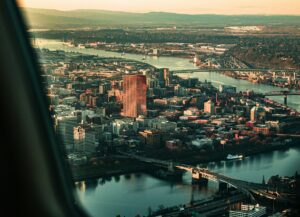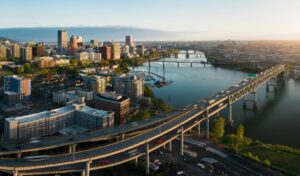When you move to Portland, you’ll discover that there is always something new to explore on foot. When planning your move, you may want to make your new home in one of Portland’s most convenient, walkable neighborhoods.
Definition of Walkability
A Walk Score rewards neighborhoods with access to things like grocery stores, restaurants, libraries, parks, and schools. Another definition of walkability factors is the amount of trees, homes, crosswalks, mass transit stops, etc. You can learn more about walkability and how it is calculated at www.walkscore.com.
The problem is that not every neighborhood has everything. If you’re looking for a place to settle down with the family, what good is the world’s most pedestrian-friendly neighborhood if there are no parks or backyards in sight?
Here are the most walkable Portland neighborhoods for your specific needs:
Delicious Food – Pearl District
The Pearl District is the number one most walkable neighborhood in the city. Most residents don’t need a car for day to day errands, and the densely populated area is full of crosswalks and stoplights.
Quirky Portland Culture – Alberta Arts District & Sunnyside – Hawthorne
Many of Portland’s most famous addities are in these two locales. Both neighborhoods are slight more residential than the Pearl District, and that makes zig-zagging across the street easier and safer.
People flock from all over Portland and beyond to walk up and down NE Alberta Street and home to both Last Thursday and the Alberta Street Fair. Walking at these events is even easier in summer when the city closes the street to cars.
Sunnyside-Hawthorne is the place to go for vegan food and people-watching. The Bagdad Theater on Hawthorne Street is only a few walkable blocks away from the local New Seasons Market.
For Families with Kids or Pets – Sellwood/Moreland
Sellwood/Moreland, though still close to the city center, is a more relaxed, residential neighborhood. It’s ideal for anyone looking for a mix of walkable and family-friendly. With a post office, grocery store, and several banks in the area, residents can take care of most errands on foot.
You’ll find no shortage of restaurants and coffee shops either. Sellwood even has a small food cart hub on 13th Avenue. Families with kids make good use of the neighborhood’s large park, pool, and public library.
Old Portland History & Nightlife – Old Town Chinatown
Old Town is the second most walkable neighborhood in Portland according to Walk Score. You can even go on an underground walking tour where you’ll learn several terrifying facts about Portland’s rough history.
The neighborhood also has an active nightlife. It is peppered with small concert halls and nightclubs. If that is not your cup of tea, you’ll also find a retro supper club with nightly live jazz music.
Boutique Shopping – Alphabet District
The Alphabet District (also know as Northwest Portland) has a densely populated shopping hub. NW 23rd Avenue is lined with small boutiques in old Victorian houses. Though you’ll also find plenty of bigger establishments as well.
When your feed a rest between stores, respite is not far off. The neighborhood also has more than 300 restaurants, bars and coffee shops.
For People with No plan – Downtown
The city’s highly walkable downtown areas has it all. Everything is so tightly packed. It’s easy to see a lot just by exploring. If you run out of ideas, the Portland Art Museum is less than a five minute walk from Pioneer Square.
If it’s food that you crave, you’ll find more than 500 restaurants, bars and coffee shops in Downtown. And the streets around Portland State University offer plenty of sweet and savory food cart options.




